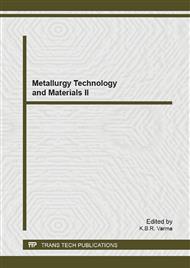[1]
F. Favier, E. C. Walter, Z. M. P., T. Benter, and R. M. Penner, Hydrogen Sensors and Switches from Electrodeposited Palladium Mesowire Arrays, Science 293, 2227 (2001).
DOI: 10.1126/science.1063189
Google Scholar
[2]
A. Javey, J. Guo, Q. Wang, M. Lundstrom, and H. Dai, Ballistic carbon nanotube field-effect transistors, Nature 424, 654 (2003).
DOI: 10.1038/nature01797
Google Scholar
[3]
D. A. Stewart, Ab-initio investigation of phonon dispersion and anomalies in palladium. New J. Phys. 10, 043025 (2008).
DOI: 10.1088/1367-2630/10/4/043025
Google Scholar
[4]
J. M. Walsh, M. H. Rice, R. G. Mcqueen, and F. L. Yarger, Shock-Wave Compressions of Twenty-Seven Metals. Phys. Rev. 108, 196 (1957).
DOI: 10.1103/physrev.108.196
Google Scholar
[5]
H. K. Mao, P. M. Bell, J. W. Shaner, and D. J. Steinberg, Specific volume measurements of Cu, Mo, Pd, and Ag and calibration of the ruby R1 fluorescence pressure gauge from 0. 06 to 1 Mbar, J. Appl. Phys. 49, 3276 (1978).
DOI: 10.1063/1.325277
Google Scholar
[6]
Y. Fei, J. Li, K. Hirose, W. Minarik, J. V. Orman, C. Sanloup, W. V. Westrenen, T. Komabayashi, and K. Funakoshi, A critical evaluation of pressure scales at high temperatures by in situ X-ray diffraction measurements, Phys. Earth Planet. Int. 143, 515 (2004).
DOI: 10.1016/j.pepi.2003.09.018
Google Scholar
[7]
A. Chijioke, W. J. Nellis, and I. F. Silvera, High-pressure equations of state of Al, Cu, Ta, and W, J. Appl. Phys. 98, 073526 (2005).
DOI: 10.1063/1.2071449
Google Scholar
[8]
B. Stritzker, Superconductivity in Irradiated Palladium, Phys. Rev. Lett. 42, 1769 (1979).
DOI: 10.1103/physrevlett.42.1769
Google Scholar
[9]
R. Konig, A. Schindler, and T. Herrmannsdorfer, Superconductivity of Compacted Platinum Powder at Very Low Temperatures, Phys. Rev. Lett. 82, 4528 (1999).
DOI: 10.1103/physrevlett.82.4528
Google Scholar
[10]
T. Takezawa, H. Nagara, and N. Suzuki, Ab initio calculations of superconductivity in palladium under pressure, Phys. Rev. B 71, 012515 (2005).
DOI: 10.1103/physrevb.71.012515
Google Scholar
[11]
G. Y. Guo, Ab initio calculation of intrinsic spin Hall conductivity of Pd and Au, J. Appl. Phys. 105, 07C701 (2009).
DOI: 10.1063/1.3054362
Google Scholar
[12]
S. Baroni, P. Giannozzi, and A. Testa, Green's-function approach to linear response in solids, Phys. Rev. Lett. 58, 1861 (1987).
DOI: 10.1103/physrevlett.58.1861
Google Scholar
[13]
S. Baroni, S. D. Gironcoli, A. D. Corso, and P. Giannozzi, Phonons and related crystal properties from density-functional perturbation theory, Rev. Mod. Phys. 73, 515 (2001).
DOI: 10.1103/revmodphys.73.515
Google Scholar
[14]
P. Giannozzi, S. Baroni, N. Bonini, M. Calandra, R. Car, C. Cavazzoni, D. Ceresoli, G. L. Chiarotti, M. Cococcioni, I. Dabo, A. D. Corso, S. D. Gironcoli, S. Fabris, G. Fratesi, R. Gebauer, U. Gerstmann, C. Gougoussis, A. Kokalj, M. Lazzeri, L. Martin-Samos, N. Marzari, F. Mauri, R. Mazzarello, S. Paolini, A. Pasquarello, L. Paulatto, C. Sbraccia, S. Scandolo, G. Sclauzero, A. P. Seitsonen, A. Smogunov, P. Umari, and R. M. Wentzcovitch, QUANTUM ESPRESSO: a modular and open-source software project for quantum simulations of materials, J. Phys. Condens. Matter 21, 395502 (2009).
DOI: 10.1088/0953-8984/21/39/395502
Google Scholar
[15]
J. P. Perdew and A. Zunger, Self-interaction correction to density-functional approximations for many-electron systems, Phys. Rev. B 23, 5048 (1981).
DOI: 10.1103/physrevb.23.5048
Google Scholar
[16]
D. Vanderbilt, Soft self-consistent pseudopotentials in a generalized eigenvalue formalism, Phys. Rev. B 41, 7892 (1990).
DOI: 10.1103/physrevb.41.7892
Google Scholar
[17]
J. P. Perdew, K. Burke, and M. Ernzerhof, Generalized Gradient Approximation Made Simple, Phys. Rev. Lett. 77, 3865 (1996).
DOI: 10.1103/physrevlett.77.3865
Google Scholar
[18]
H. J. Monkhorst and J. D. Pack, Special points for Brillouin-zone integrations, Phys. Rev. B 13, 5188 (1976).
DOI: 10.1103/physrevb.13.5188
Google Scholar
[19]
Z. L. Liu, J. H. Yang, L. C. Cai, F. Q. Jing, and D. Alfè, Structural and thermodynamic properties of compressed palladium: Ab initio and molecular dynamics study, Phys. Rev. B 83, 144113 (2011).
DOI: 10.1103/physrevb.83.144113
Google Scholar
[20]
B. Allen and R. C. Dynes, Transition temperature of strong-coupled superconductors reanalyzed, Phys. Rev. B 12, 905 (1975).
DOI: 10.1103/physrevb.12.905
Google Scholar
[21]
W. L. McMillan, Transition Temperature of Strong-Coupled Superconductors, Phys. Rev. 167, 331 (1968).
DOI: 10.1103/physrev.167.331
Google Scholar
[22]
G. M. Eliashberg, Sov. Phys. -JETP 16, 780 (1962).
Google Scholar
[23]
P. B. Allen and B. Mitrovic, Solid State Physics, edited by H. Ehrenreich, F. Seitz, and D. Turnbull (Academic, New York, 1982).
Google Scholar
[24]
S. K. Bose, T. Kato, and O. Jepsen, Superconductivity in boron under pressure: A full-potential linear muffin-tin orbitals study, Phys. Rev. B 72, 184509 (2005).
DOI: 10.1103/physrevb.72.184509
Google Scholar
[25]
S. Y. Savrasov and D. Y. Savrasov, Electron-phonon interactions and related physical properties of metals from linear-response theory, Phys. Rev. B 54, 16487 (1996).
DOI: 10.1103/physrevb.54.16487
Google Scholar
[26]
F. J. Pinski and W. H. Butler, Calculated electron-phonon contributions to phonon linewidths and to the electronic mass enhancement in Pd, Phys. Rev. B 19, 6010 (1979).
DOI: 10.1103/physrevb.19.6010
Google Scholar


